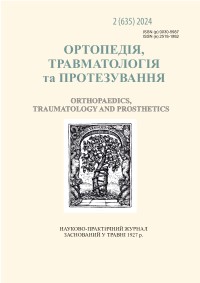PARAMETERS OF THE INTERCONDYLAR FOSSA OF THE FEMUR IN CHILDRENIN NORMAL CONDITIONS AND WITH CONGENITAL MALFORMATIONS OF THE LOWER LIMBS
DOI:
https://doi.org/10.15674/0030-59872024261-68Keywords:
Knee joint, congenital defects of the lower limb, radiography, instability of the knee jointAbstract
According to literature sources, radiography can indirectly visualize congenital insufficiency of the cruciate ligaments both in isolated form and in combination with other congenital malformations of the lower extremities. Objective. To study the parameters of the intercondylar fossa of the femur in children of different age groups with stable/unstable knee jo ints due to congenital malformations of the lower limbs using instrumental imaging methods. Methods. A prospective diagnostic study was conducted of 359 knee joints of 217 children who were treated at the pediatric orthopedics clinic from 2019
to 2022 and with a retrospective control group (2010–2021). limbs, as well as with congenital malformations of the lower limbs. X-ray examinations were performed on the OPERA T90cex X-ray and fluoroscopic system. Results. 217 patients took part in the study, including 105 patients without knee joint
pathology and 112 with congenital malformations of the lower limbs. Comparison of the accuracy of radiological diagnostic indicators was performed using the Studentʼs t-test with the results of computer and magnetic resonance imaging studies, which showed the absence of a statistically significant difference
in the results research. A diagnostic study was also conducted to find the regularity of the development of the knee joints and to identify the parameters of the radiological norm of the development of the intercondylar fossa of the femur in children of different age categories. Conclusions. Using the results
of instrumental studies, the parameters of the intercondylar fossa of the femur in children of different age categories with stable and unstable knee joints due to congenital malformations of the lower limbs were investigated. The results of the study should be taken into account for the diagnosis of congenital defects of the knee joint.
References
- Leite, C. B., Grangeiro, P. M., Munhoz, D. U., Giglio, P. N., Camanho, G. L., & Gobbi, R. G. (2021). The knee in congenital femoral deficiency and its implication in limb lengthening: A systematic review. EFORT Open Reviews, 6(7), 565-571. doi:10.1302/2058-5241.6.200075
- Chomiak, J., Podškubka, A., Dungl, P., Ošt'ádal, M., & Frydrychová, M. (2012). Cruciate ligaments in proximal femoral focal deficiency. Journal of Pediatric Orthopaedics, 32(1), 21-28. doi:10.1097/bpo.0b013e31823d34db
- Paley, D., Standard, S. C., & Wiesel, S. W. (2010). Treatment of congenital femoral deficiency. Operative techniques in orthopaedic surgery. Philadelphia : lippincott Williams & Wilkins
- Khmyzov, S. O., Yakushkin, E. S., & Katsalap, E. S. (2021). Instability of the knee joint under the conditions of congenital malformations of the lower limbs (literature review). Orthopedics, traumatology and prosthetics, 1, 80-85. DOI: http://dx.doi.org/10.15674/0030-59872021180-85. (in Ukrainian)
- Mindler, G. T., Radler, C., & Ganger, R. (2016). The unstable knee in congenital limb deficiency. Journal of Childrenʼs Orthopaedics, 10(6), 521-528. doi:10.1007/s11832-016-0784-y
- Manner, H. M., Radler, C., Ganger, R., & Grill, F. (2006). Dysplasia
- of the cruciate ligaments. The Journal of Bone and Joint
- Surgery-American Volume, 88(1), 130-137. doi:10.2106/00004623-
- -00016
- Walker, J. L., Milbrandt, T. A., Iwinski, H. J., & Talwalkar, V. R.
- (2019). Classification of cruciate ligament dysplasia and the severity
- of congenital fibular deficiency. Journal of Pediatric
- Orthopaedics, 39(3), 136-140. doi:10.1097/bpo.0000000000000910
- Sadofyeva, V. I. (1990). Normal x-ray anatomy of the osteoarticular
- system of children. L. : Medicine. (in russian)
- Bontrager, K. L., & Lampignano, J. P. (2014). Textbook of Radiographic
- Positioning and Related Anatomy. 8th ed. St. Louis
- (Mo.) : Elsevier Mosby
- Moeller, T. B. (2007). Pocket Atlas of Sectional Anatomy :
- Computer Tomography and Magnetic Resonance Imaging.
- rd ed., rev. and enl. Stuttgart: Thieme
Downloads
How to Cite
Issue
Section
License

This work is licensed under a Creative Commons Attribution 4.0 International License.
The authors retain the right of authorship of their manuscript and pass the journal the right of the first publication of this article, which automatically become available from the date of publication under the terms of Creative Commons Attribution License, which allows others to freely distribute the published manuscript with mandatory linking to authors of the original research and the first publication of this one in this journal.
Authors have the right to enter into a separate supplemental agreement on the additional non-exclusive distribution of manuscript in the form in which it was published by the journal (i.e. to put work in electronic storage of an institution or publish as a part of the book) while maintaining the reference to the first publication of the manuscript in this journal.
The editorial policy of the journal allows authors and encourages manuscript accommodation online (i.e. in storage of an institution or on the personal websites) as before submission of the manuscript to the editorial office, and during its editorial processing because it contributes to productive scientific discussion and positively affects the efficiency and dynamics of the published manuscript citation (see The Effect of Open Access).














